Best Wishes for the New Year!
-
Recent Posts
Categories
Archives
Meta
Best Wishes for the New Year!
*Check back later this summer for exciting fall 2017 programs!
FEBRUARY
MARCH
APRIL
MAY
JUNE
JULY
SEPTEMBER
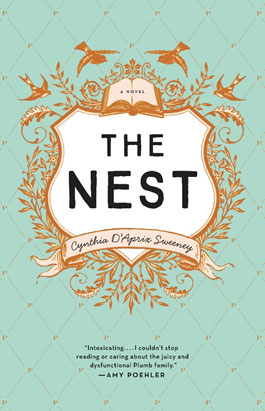 Cynthia D’Aprix Sweeney brings a remarkable cast of characters to life in a story about the power of family, the possibilities of friendship, the ways we depend upon one another and the ways we let one another down. In this tender, entertaining, and deftly written debut, discover what it means to be family.
Cynthia D’Aprix Sweeney brings a remarkable cast of characters to life in a story about the power of family, the possibilities of friendship, the ways we depend upon one another and the ways we let one another down. In this tender, entertaining, and deftly written debut, discover what it means to be family.
Years of simmering tensions reach a breaking point on an unseasonably cold afternoon in New York City as Melody, Beatrice, and Jack Plumb gather to confront their charismatic and reckless older brother, Leo, freshly released from rehab. The Plump family is falling apart along with the security of their trust fund, “the nest”, and Leo might be the only one who can pull them back together.
Check it out in the Popular Reading Section today!
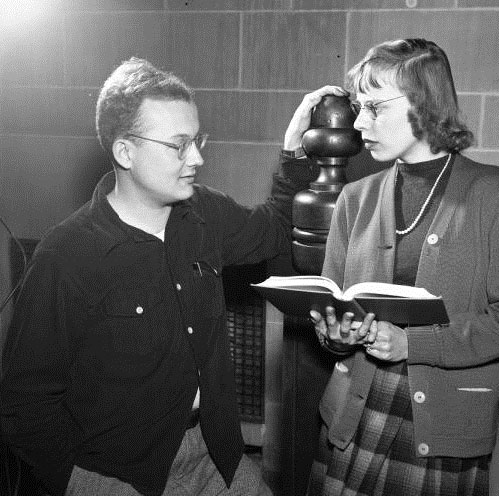 This is the time of the year for winter storms, but most of them do not cost students their homes. A Sound Past includes a photograph of married College of Puget Sound juniors Gerald Perry ’51 and Ruth (Matlock) Perry ’51 standing inside the front door of Howarth Hall, January 1950, looking perfectly normal, but probably not feeling that way after their apartment at 3825 Ruston Way was destroyed during the huge blizzard of 13 January 1950. In those days Ruston Way was a winding road along the water front, home to ships and saw mills, but not rollerbladers. The Perry’s apartment stood over the water on log pilings. When classes were canceled as the storm raged, they returned home to find it was no longer there, destroyed by storm-tossed logs that had escaped from a nearby mill’s log boom. The Perrys lost all their belongings, including “a Turkish coffee pot, an elephant’s foot and a group of oil paintings from Naples” that Gerald had picked up during his stint in the Merchant Marine. Also gone were the couple’s silver wedding set and their schoolbooks. Said Gerald, “The only thing we can do is start all over again.” Their senior year they found a place to live only three blocks from campus.
This is the time of the year for winter storms, but most of them do not cost students their homes. A Sound Past includes a photograph of married College of Puget Sound juniors Gerald Perry ’51 and Ruth (Matlock) Perry ’51 standing inside the front door of Howarth Hall, January 1950, looking perfectly normal, but probably not feeling that way after their apartment at 3825 Ruston Way was destroyed during the huge blizzard of 13 January 1950. In those days Ruston Way was a winding road along the water front, home to ships and saw mills, but not rollerbladers. The Perry’s apartment stood over the water on log pilings. When classes were canceled as the storm raged, they returned home to find it was no longer there, destroyed by storm-tossed logs that had escaped from a nearby mill’s log boom. The Perrys lost all their belongings, including “a Turkish coffee pot, an elephant’s foot and a group of oil paintings from Naples” that Gerald had picked up during his stint in the Merchant Marine. Also gone were the couple’s silver wedding set and their schoolbooks. Said Gerald, “The only thing we can do is start all over again.” Their senior year they found a place to live only three blocks from campus.
Read about the Perrys’ loss on page 6 of the 23 January 1950 issue of The Trail at:
http://soundideas.pugetsound.edu/thetrail_all/538/
The Archives & Special Collections is open on Tuesdays, Wednesdays, and Thursdays from 12:00-3:00 p.m. or by appointment.
By John Finney
Last Summer Collins Library received a generous donation of vintage bookmarks, ranging in age from the 1800’s to the 1950’s. For the past few weeks I have been given the privilege to work with these tiny treasures. The sheer size of the donation, hundreds of artifacts, varying in size, colors, style, and historical significance, made it difficult to immediately ascertain how the items should be categorized and stored. So for the time being, the collection lives in a small study room in the basement of the library, where for two hours a day, five days week, I get to work with them.
Before embarking on this project, I had no idea how rich of a history there was surrounding bookmarks. Nowadays, we’re perfectly content using any old scrap of paper to mark our place in a book (if we’re not using our kindles, Iphones, tablets, or various other reading devices), and most of us are completely remiss about dog-earing pages or marking up our favorite passages. In fact, many consider tears, stains, markings, and all other minute imperfections to be tell tale signs of a book well loved. However, this was not the case in the 1800’s. Back then to be in possession of books, and to be literate to begin with, was a cherished privilege. And as a result, bookmarks, were a highly desirable keepsake, first being exchanged as handmade gifts, often crafted from fine silk ribbons with hand painted or embroidered designs. Just take a look at some of these beautifully crafted bookmarks in our collection:
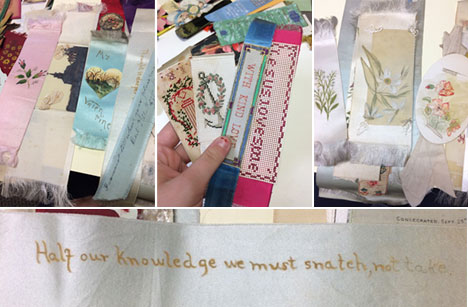 Bookmarks then eventually evolved to the precursor of modern-day greeting cards, being massed produced by corporations for a variety of Holidays and occasions. One such printing Company that is well documented is Stevents Bookmarks, which produced a variety of intricately woven bookmarks from 1862 to 1876.
Bookmarks then eventually evolved to the precursor of modern-day greeting cards, being massed produced by corporations for a variety of Holidays and occasions. One such printing Company that is well documented is Stevents Bookmarks, which produced a variety of intricately woven bookmarks from 1862 to 1876.
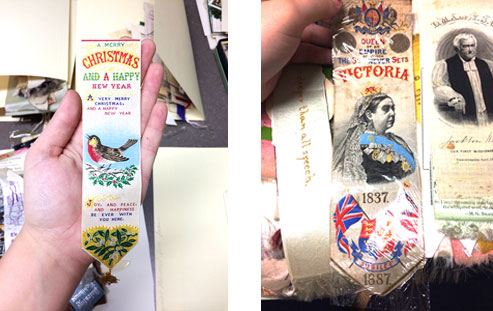 As the mass production of bookmarks progressed, they became the perfect outlet for advertising as well.
As the mass production of bookmarks progressed, they became the perfect outlet for advertising as well.
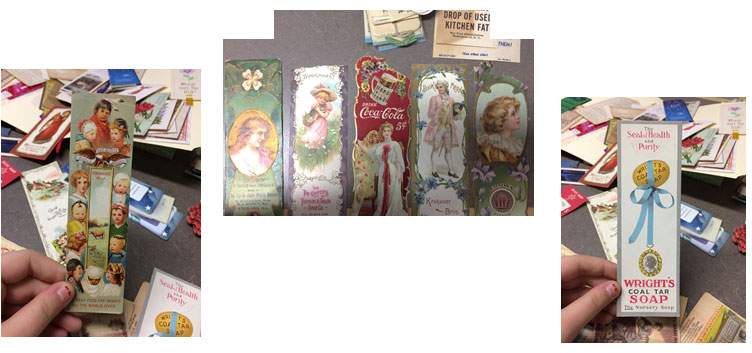 The collection even includes WWII propaganda bookmarks.
The collection even includes WWII propaganda bookmarks.
All of these fine bookmarks harken back to a time when to own a book was not such a sure thing, and to read was a cherished privilege. These bookmarks may seem like trifles to some, easily forgotten or overlooked, but they hold a rich history and give us insight into our ever evolving relationship with the written word.
Stay tuned for the next chapter!
– Carlisle
 Wednesday, Dec. 14, 2016
Wednesday, Dec. 14, 2016
11am-12:30pm
Collins Memorial Library, Second floor, Archives Lecture Space
Pop-up books captivate and excite the child in all of us. They come to life as three-dimensional works of art hidden inside the pages of a book. Pop-Up Now II will feature handmade artist books that pop-up, move, slide, twirl, whirl, light up, or even sound off. This international, juried exhibition of handmade pop-up and movable artist books will delight viewers everywhere.
Read more at: http://www.23sandy.com/
Introduction:
This blog was made for the class Humanities 399: Library as Collaboratory. Students had the choice to select from a variety of different projects to expand their knowledge as liberal arts students and grow their knowledge about a small library project. It was meant to be a very reflective project and encourage students to think about their own skills they have developed as students while also working to push themselves to apply those skills in new ways.
So what are zines?
A zine is a self-published publication, often motivated by a desire for some form of creative self-expression, not for profit. People sometimes will sell zines, but it usually is just to cover the costs of productions. They can range from short comics or short stories to critical literature such as anarchist literature, feminist literature, etc.
How does one collect these zines and make them accessible to others?
There are many different ways that Zines are collected. They can be collected through various festivals (referenced by many of the different zines in the collection I worked with) or various projects that make them more accessible to a wider audience.
One of these that I discovered that I wanted to highlight was The Zine Archive and Publishing Project (ZAPP) which is an entirely volunteer based archive of 30,000 plus self-published materials that are meant to “validate publications outside the literary mainstream” for people to have access to (http://zappseattle.org/wp/about-2-0/).
They are able to hold various events to display the large amount of content they are working with, all in the pursuit of increasing access to these zines. Speaking of which, it is important to note that there is no one zine, they are all unique in their content and varied in the way they are put together.
What do these zines look like? Here are some good examples with descriptions
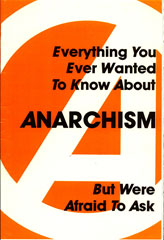 This first zine begins in a more radical fashion as it was first published by what is called The Anarchist Media Group and is meant to help people understand what anarchism is because “there is probably more rubbish talked about anarchism than any other political idea” which they hope to address. This literature embodies more of the critical approaches seen in zines that seek to disrupt the idea of authority and challenge people to think critically about previous conceptions they had about state formation. It even includes a final portion that provides a list of further things to read that builds upon the zine.
This first zine begins in a more radical fashion as it was first published by what is called The Anarchist Media Group and is meant to help people understand what anarchism is because “there is probably more rubbish talked about anarchism than any other political idea” which they hope to address. This literature embodies more of the critical approaches seen in zines that seek to disrupt the idea of authority and challenge people to think critically about previous conceptions they had about state formation. It even includes a final portion that provides a list of further things to read that builds upon the zine.
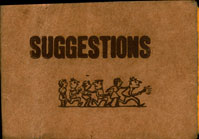 This next zine is much tamer in tone and serves to mainly provide small suggestions for life such as “try not to worry too much” about anything (something that the anarchists probably would disagree with) which pretty aptly sums up the entire zine. These short words of suggestion are merely meant to be ideas offered to whoever ends up reading them and represents the more whimsical zines that are published.
This next zine is much tamer in tone and serves to mainly provide small suggestions for life such as “try not to worry too much” about anything (something that the anarchists probably would disagree with) which pretty aptly sums up the entire zine. These short words of suggestion are merely meant to be ideas offered to whoever ends up reading them and represents the more whimsical zines that are published.
 The next zine is similar to the one about anarchism, but this also provides a more narrative history about the work of a group called MOVE which was based in West Philadelphia. The group was meant to facilitate a revolution to “show people how corrupt, rotten, criminally enslaving this system is” by being a positive force in the community and also take place in various demonstrations against the police. The zine chronicles the history of the group and the various conflicts they got into that led them to be branded as terrorists in the struggle that they are continuing to educate about.
The next zine is similar to the one about anarchism, but this also provides a more narrative history about the work of a group called MOVE which was based in West Philadelphia. The group was meant to facilitate a revolution to “show people how corrupt, rotten, criminally enslaving this system is” by being a positive force in the community and also take place in various demonstrations against the police. The zine chronicles the history of the group and the various conflicts they got into that led them to be branded as terrorists in the struggle that they are continuing to educate about.
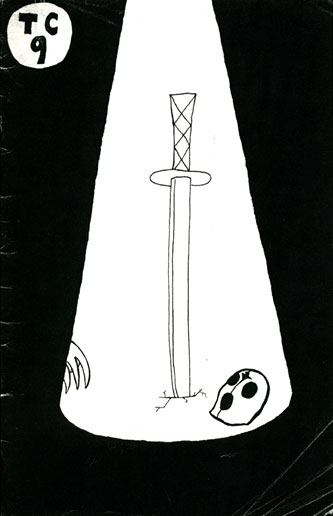 This next zine is a comic that tells the story of a hero named Danger Flamethrower who is a detective that is attempting to solve a crime. It is humorous in tone and even crossing into absurd with a chicken randomly entering the story to complicate matters. This piece shows how zines can be silly without having to even make the most sense and can instead embrace a more chaotic approach to whatever they publish.
This next zine is a comic that tells the story of a hero named Danger Flamethrower who is a detective that is attempting to solve a crime. It is humorous in tone and even crossing into absurd with a chicken randomly entering the story to complicate matters. This piece shows how zines can be silly without having to even make the most sense and can instead embrace a more chaotic approach to whatever they publish.
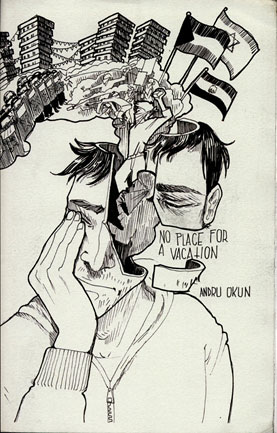 This zine takes the narrative aspect seen previously but makes it the central focus. It is the self-told narrative about the author, Andru Okun, going for 3 months to travel through Israel, Palestine, Egypt, and Jordan. It serves as not just as a physical journey however, but is instead also a spiritual journey where the author grows as a person as well. Throughout one sees various conflicts that make for a compelling story and another form of a zine worth highlighting.
This zine takes the narrative aspect seen previously but makes it the central focus. It is the self-told narrative about the author, Andru Okun, going for 3 months to travel through Israel, Palestine, Egypt, and Jordan. It serves as not just as a physical journey however, but is instead also a spiritual journey where the author grows as a person as well. Throughout one sees various conflicts that make for a compelling story and another form of a zine worth highlighting.
The process of constructing metadata
It is admittedly an arduous process that requires you to identify obvious components such as Title, Author but then requires more in depth analysis when it comes to things like Subject Headings. Subject Headings are done through the Library of Congress Authorities where you can easily look through and identify authority headings for Subject, Name, Title and Name/Title combination in order to better find what you are looking for. Here is an excerpt of the metadata collection I did:
This ideally will be then used to assist in the collection that is put together to better organize what ended up being a lot of zines that were incredibly varied in the content and construction of them.
So what should be done with Zines?
Continue to make them accessible in libraries, exhibits, databases, and however they can be shown to better inform folks about what this unique form of publications truly are!
By Chase Hutchinson
As I wrap up the Library as Collaboratory course and reflect on what I learned, I am amazed at the stark contrast from what I expected when I signed up for this course. All it took for me to add this course to my shopping cart was that the quarter credit that fit into my schedule and most importantly it was about libraries in someway. When I found out that the course was actually about digital humanities and how the liberal arts could be used in a work setting, I was all the more ecstatic. As a college senior I was looking for any and all opportunities on how I could use my degree, and in this age of rapid fire technological growth, becoming competent in anything digital seemed to be a win win.
The course was set up so that each person in the class would be working in small groups with a librarian on a project that incorporated the digital humanities. We would be in charge of project design, managing our own timeline, and communicating with the other group members and the librarian to get the project done. By a grab-bag choice, I worked on the zine metadata project. I knew almost nothing about metadata and only cursory information about zines, so I was guaranteed to learn something from this project.
Metadata is what makes the four stories of our library searchable with the single click of a button. According to Merriam-Webster, metadata has the titillating definition of ‘data that describes other data.’ For the library, this means any information they have logged about a specific item, such as a book or a magazine, in the collection. This is all searchable data, and it is what pops up when you are looking for a specific item in the library using a computer.
I have worked with metadata for many years now; it was a key part of how I found resources for references for my countless research papers and, well, anything in the library. However, I had never put any thought at all into how those small paragraphs under book titles with my searched phrases highlighted in yellow popped up. I might have thought at one point that they were pulled from the abstracts of books, or that some combination of publisher, author, and librarian compiled the list, or even that they were computer generated (I’m not sure how this would have worked, but that’s kind of the point, isn’t it?).
When I was tasked with creating metadata for the zines, I thought that I would just be summarizing the content and listing important data such as title and author. This is what I actually ended up doing:
Creating metadata is actually a very specific process; for many of the columns you see I had to use controlled vocabulary, which meant that I could only use words from a list. For example, under ‘binding’ I couldn’t just put ‘stapled,’ I had to put ‘saddle stitching.’ This may all seem entirely too bureaucratic and finicky to be of any actual use, but this is all for a purpose. Remember; all of this information is going to be searchable soon. It needs to make sense, and because metadata is created by many different people all the time, there needs to be some standards for what is put in when and where to make sure utter chaos does not reign.
Of course, the format of a zine doesn’t always lend itself to easy metadata. Zine as a genre continually defy defining. The only requirements for a zine being categorized as such is that it needs to have a small publication, and they are generally the size of a regular sheet of printer paper folded in quarters. However, even these loose definitions can be and are bent, and mostly if a creator claims that what they published is a zine, then that is what it is. There are no regulations to include a copyright nor the name of the author. Often a single zine can cover many different genres and topic within the span of only a dozen or so pages.
As maddening as that all was, though, it was also an integral part to what makes zines so important. They are often written by people or groups of people who feel outcast or marginalized by society. They are the results of people struggling to make themselves heard on a platform which they control and which can’t be controlled by anyone else. These little pamphlets hold some of the most raw and honest accounts of what it is like to be human that I’ve ever read, and it has been an honor to read them.
By Ada Smith
 The phenomenal true story of the black female mathematicians at NASA at the leading edge of the feminist and civil rights movement, whose calculations helped fuel some of America’s greatest achievements in space. A powerful, revelatory contribution that is as essential to our understanding of race, discrimination, and achievement in modern America as Between the World and Me or The Immortal Life of Henrietta Lacks.
The phenomenal true story of the black female mathematicians at NASA at the leading edge of the feminist and civil rights movement, whose calculations helped fuel some of America’s greatest achievements in space. A powerful, revelatory contribution that is as essential to our understanding of race, discrimination, and achievement in modern America as Between the World and Me or The Immortal Life of Henrietta Lacks.
Soon to be a major motion picture starring Taraji P. Henson, Octavia Spencer, Janelle Monae, Kirsten Dunst, and Kevin Costner.
Check it out in the Popular Ready Collection today!
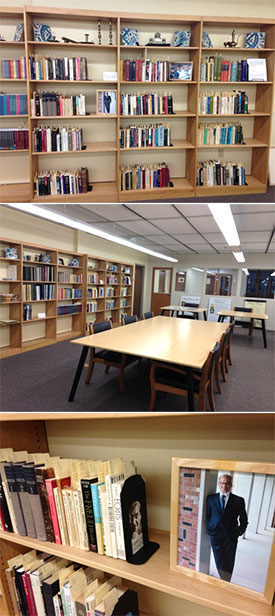 Good news! For those of you who haven’t already visited the Archives & Special Collections this year, we got a makeover! Walls have been added, windows, doors, the whole shebang… but it doesn’t stop there! We just recently received our new reading room furniture! Spacious tables and comfy chairs brought to you in order to enhance your archival experience. But wait, there’s more! In the reading room you will find a new collection as well!
Good news! For those of you who haven’t already visited the Archives & Special Collections this year, we got a makeover! Walls have been added, windows, doors, the whole shebang… but it doesn’t stop there! We just recently received our new reading room furniture! Spacious tables and comfy chairs brought to you in order to enhance your archival experience. But wait, there’s more! In the reading room you will find a new collection as well!
Our former President, Ronald R. Thomas, has donated some of his personal library to the Archives & Special Collections. This collection focuses on what RonThom calls “’the long nineteenth century,’ the period stretching from the Victorian Age through Modernity.” A period of big ideas, RonThom describes how these pieces of literature have peaked his curiosity, shaped his thoughts regarding life and literature, and informed his scholarly work. “Literature is everything,” he says, referring to this collection as the “X-ray of the heart of my collection. But there is always so much more to see.” So please come check it out and see what you can find!
The Archives & Special Collections is open on Tuesdays, Wednesdays, and Thursdays from 12:00-3:00 p.m. or by appointment.
By Monica Patterson